Hydrogeological situation on 1 September 2023
In August, the depletion continued for all aquifers and their levels were on the whole decreasing (73%). However, in the northern third of the country, rainfall in July and August enabled water levels to be maintained or to be recharged.
The situation improved between July and August: 62% of aquifer levels remained below monthly averages in August 2023, whereas this had been 72% in July. The situation is improving mainly in the water tables in the northern third of the country. However, aquifer levels remained below seasonal norms over much of the country, particularly around the Mediterranean, and in the Rhône-Saône corridor and southern Alsace.
Aquifer levels are likely to continue falling until the low-water period, which is usually observed between mid-October and November. In September, the state of the aquifers will depend mainly on local effective rainfall and the sensitivity of the aquifers in question. For the southern two-thirds of the country, effective rainfall will first need to moisten the soil and support vegetation, before it can infiltrate more deeply into the ground.
Low water levels in 2023 are likely to be particularly severe in the Rhône-Saône corridor and around the Mediterranean. The situation will need to be closely monitored in aquifers which currently have levels that are below the monthly norms, as well as in areas where abstraction demand is particularly high.
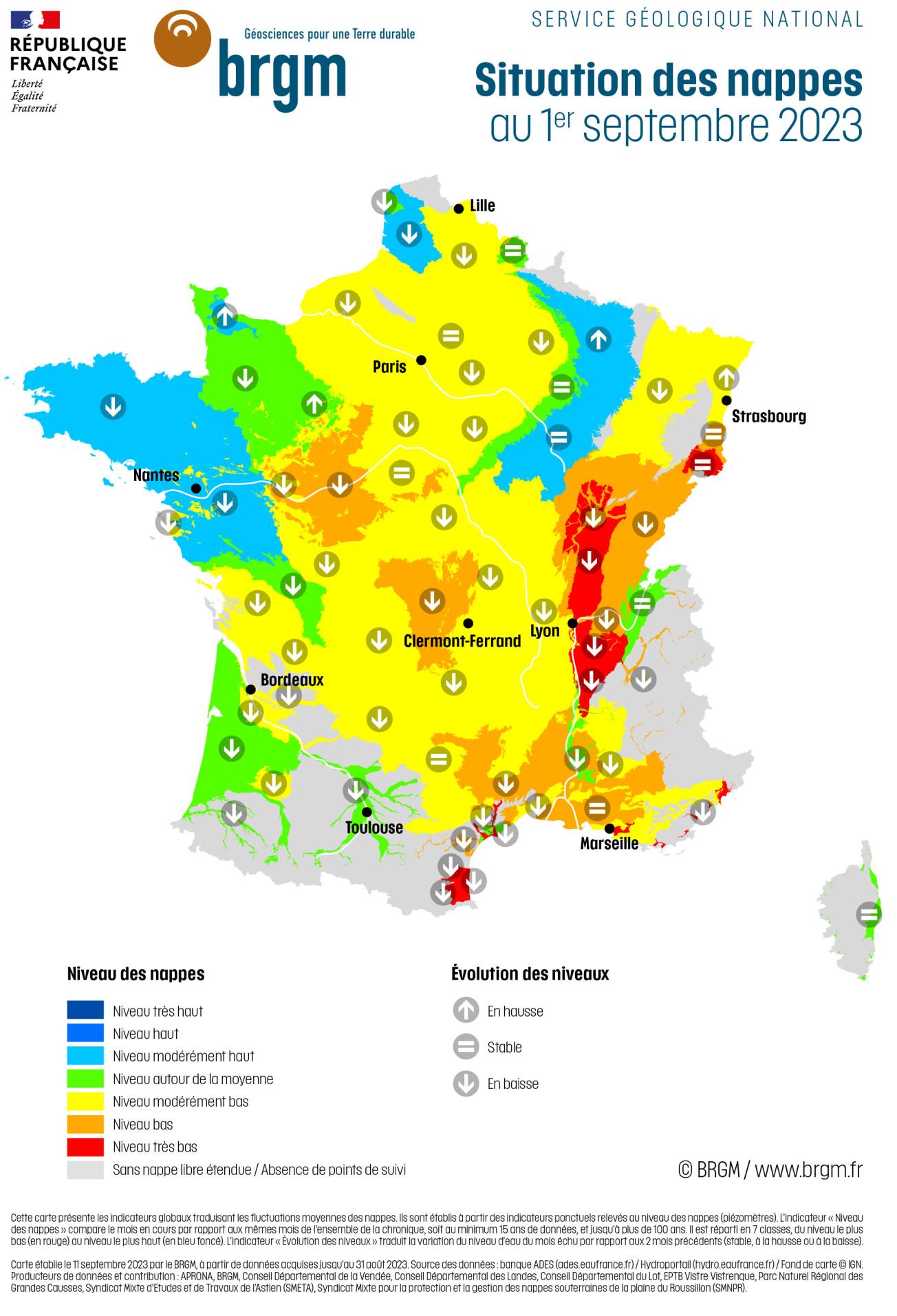
Map of aquifer levels in mainland France on 1 September 2023.
© BRGM
Groundwater trends
The 2022-2023 recharge period was deficient over a large part of France, although early spring rainfall led to recharge episodes, thus delaying the start of the depletion period in those areas with the highest rainfall. The depletion period began gradually between March and May. In June and in July, rainfall added little to the aquifers. It only sustained the levels of reactive aquifers located under areas that received a lot of rain.
In August, the depletion continued and most aquifer levels were falling: levels dropped at 73% of the observation points (compared to 89% in July).
In the northern third of France, rainfall in July and August led to recharge episodes in August, while at the same time reducing water abstraction. The impact on piezometric levels depends on the reactivity of the aquifer and local rainfall totals. Most of the reactive aquifers from Cotentin to Alsace showed rising or stable levels in August. Rainfall affected the inertial water tables in the Paris Basin and Artois to different extents. Generally, the rainfall was insufficient to reverse the downward trend, but the depletion was slowed. In some sectors that are less inertial or receive more rain, trends were stable or rising.
Over the southern two-thirds of the country, depletion continued. This is not surprising given the lack of rainfall during the month, in this part of the country. The speed of depletion depends essentially on the volumes abstracted. In Corsica, the rainfall recorded during Storm Réa on 28-29 August led to peaks in the recharge of highly reactive water tables.
Monitoring water table levels
In 2022, the low-water period was severe for most of the aquifers, with recharging remaining low during the autumn and winter of 2022-2023. At the end of the winter, the condition of the aquifers was therefore unsatisfactory. Rainfall in the spring and early summer helped to improve the condition of the most reactive aquifers in areas that benefitted from rainfall in the northern two-thirds of the country in April and in the southern third in June.
The overall situation improved between July and August: 19% of observation points were above monthly norms (as compared to 10% in July). Although the overall situation observed in August was the best since February 2023, levels were mostly below seasonal norms: 62% of levels remained moderately low to very low (72% in July) and 18% were very low (20% in July). Overall, the situation was more favourable than that observed last year, in August 2022, when 77% of levels were measured below normal. However, there is more of a local contrast in 2023 than in 2022.
In the northern third of the country, the situation improved for the most reactive aquifers. Levels were generally moderately high, and comparable with monthly norms for aquifers in the bedrock of the Armorican massif, Jurassic limestone of the Boulogne region and the western and eastern edges of the Paris Basin.
The rainfall of recent weeks had a less noticeable effect on the inertial aquifers, which are not very sensitive to meteorological events during the summer period. Their situation remained stable and even improved in places. This is due to levels falling more slowly than usual for August. The state of the inertial aquifers in the Artois and Paris Basins and the mixed-cyclicity aquifers in Lorraine and Alsace is not very favourable, with moderately low to low levels. The situation may be sensitive locally in the centre and south-west of the Paris Basin, with very low levels. It should be noted that the inertial chalk aquifers along the Channel coast and the Normandy coast are showing high levels. They benefited from excess winter recharge in 2022-2023 and several recharge episodes in spring and summer.
Over the southern two-thirds of the country, from the south of the Vendée to the south of Alsace, the situation remained stable or deteriorated slightly between July and August. Aquifer levels were either comparable to normal monthly levels or very low. Aquifer levels were satisfactory in Corsica and the south-west, moderately low to low in the Massif Central and very low in the east and around the Mediterranean. The risk of sea water intrusion increased in coastal areas which had low to very low water levels, from the Côte d'Azur to Roussillon. In detail, however, the situation of reactive aquifers can vary locally, depending on local rainfall totals over the last few months and the pressure exerted on the groundwater. In the inertial aquifers of the Sundgau (southern Alsace) and the Rhône-Saône corridor, levels are of some concern, from low to very low.
Aquifers in good condition
Several aquifers were found to be in good condition, with levels being moderately high in relation to the levels recorded for August in previous years:
- The levels of the Cenomanian chalk marl aquifer on the Artois-Picardy coast remained moderately high, following the high excess recharge of 2022-2023;
- The aquifers of the Armorican Massif basement were recharged during the spring and summer and their levels were moderately high;
- Aquifer levels in the Jurassic limestones of Lorraine and the Côte-des-Bars were moderately high, thanks to excess rainfall in July and August.
Aquifers in unfavourable condition
Many aquifers were in an unfavourable condition, with very low levels compared to August levels for all previous years, owing to an extreme rainfall deficit these last few months or years:
- The inertial Plioquaternary and Miocene aquifers in the Sundgau, Dijonnais, Bresse, Dombes, Nord Isère and Bas-Dauphiné areas had low to very low levels, due to several successive winter recharges of low intensity and to their very inertial behaviour;
- Levels in the alluvial aquifers on the Côte d'Azur were very low, as the 2022-2023 recharge was insufficient and depletion continued throughout the summer;
- The Hérault and Orb alluvial aquifers had very low levels, due to the lack of effective rainfall since 2022;
- The aquifers of the Roussillon multi-layer aquifer were in an unprecedented condition, with low to very low levels. Rainfall and restrictions on abstraction seem to be having a beneficial effect, but it is often localised and very insufficient to compensate for the deficits accumulated since 2022.
Comparison between 1 September 2022 and 1 September 2023
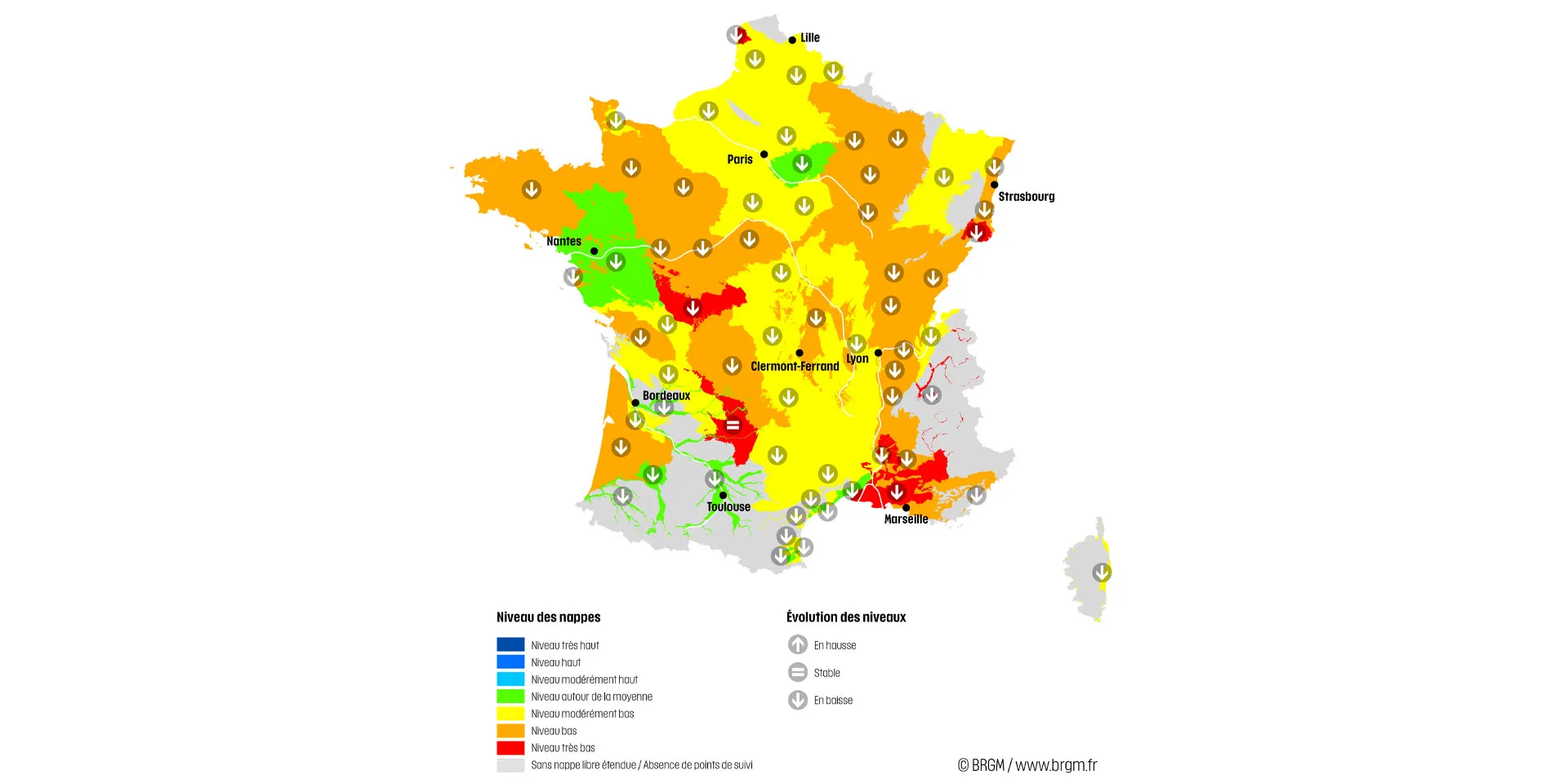
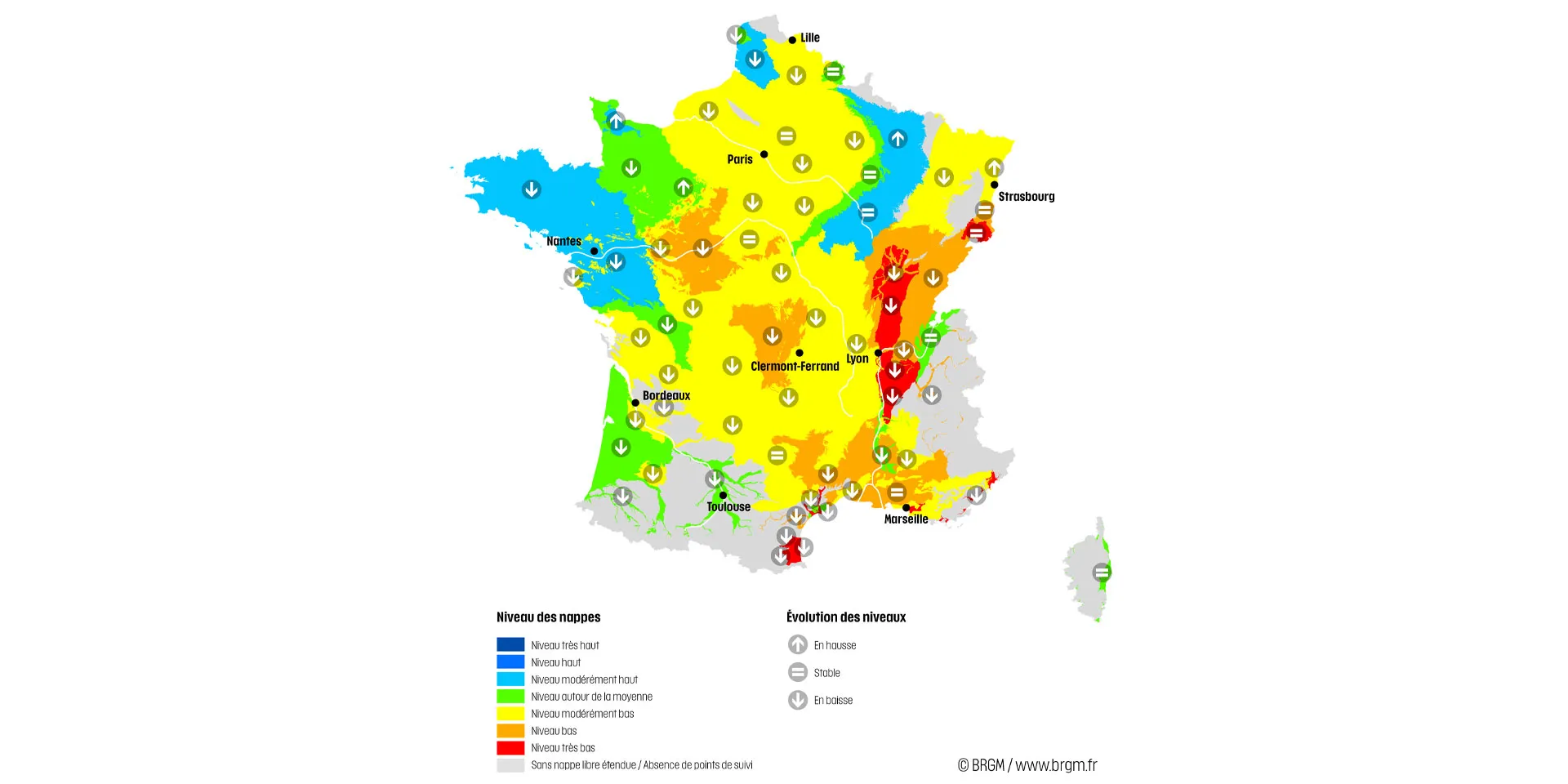
Map of France showing the state of the aquifers on 1 September 2022 (left) and 1 September 2023 (right).
© BRGM
Forecasts
The seasonal forecasts from Météo-France for September, October and November predict higher-than-normal temperatures across the country and wetter-than-normal conditions in the southernmost part of the country, from the Pyrenees to the Mediterranean basin. Elsewhere, no clear scenario has emerged for rainfall.
The conditions for recording a recharge episode and observing a possible improvement in the groundwater situation are: light but sustained rainfall that is well distributed both spatially and over time, damp soils, low demand for water from plants (low temperatures or vegetation that is not very active) and aquifers that are sensitive to meteorological events. Active vegetation and thus increased evapotranspiration usually limit the infiltration of rainfall into aquifers during summer. The high temperatures predicted by Météo-France, and which had already been observed at the beginning of September, are increasing the water requirements of vegetation as well as water abstraction.
Over the northern third of the country, the conditions are right for rain to infiltrate deeply during September. If rainfall is sufficient, we should see recharge episodes occurring. The groundwater situation could then continue to improve, more or less quickly at rates depending on the sensitivity of the aquifer and the local rainfall accumulation.
As regards reactive aquifers, the trends and developments will depend primarily on local effective rainfall. In the absence of rain, depletion is expected to resume and the situation to continue or deteriorate.
The state of the inertial aquifers should only change very slowly. The effective rainfall in July and August should continue infiltrating slowly at depth and attenuate the discharge over the coming weeks. However, the impact of these contributions should be limited.
In the southern two-thirds of the country, rainfall events are not expected to cause significant aquifer recharge. Cevennes storms, which occur frequently in September, and late summer thunderstorms, encourage run-off. Furthermore, any rainfall infiltrating the ground will initially moisten the soil, which is very dry at the moment, and benefit the vegetation.
With regard to the reactive aquifers, rainfall infiltration at depth should thus remain very limited and depletion is theoretically likely to continue in September. The situation is likely to continue deteriorating rapidly for reactive aquifers that do not benefit from small recharge events and for those that are most affected by abstraction. In the event of significant local rainfall, the situation could, however, improve temporarily.
As regards the inertial aquifers in the Sundgau (southern Alsace) and the Rhône-Saône corridor, no recharge is expected before autumn, when vegetation becomes dormant and rainfall resumes. The situation is expected to gradually deteriorate, more or less slowly, depending on the volumes of groundwater abstracted.
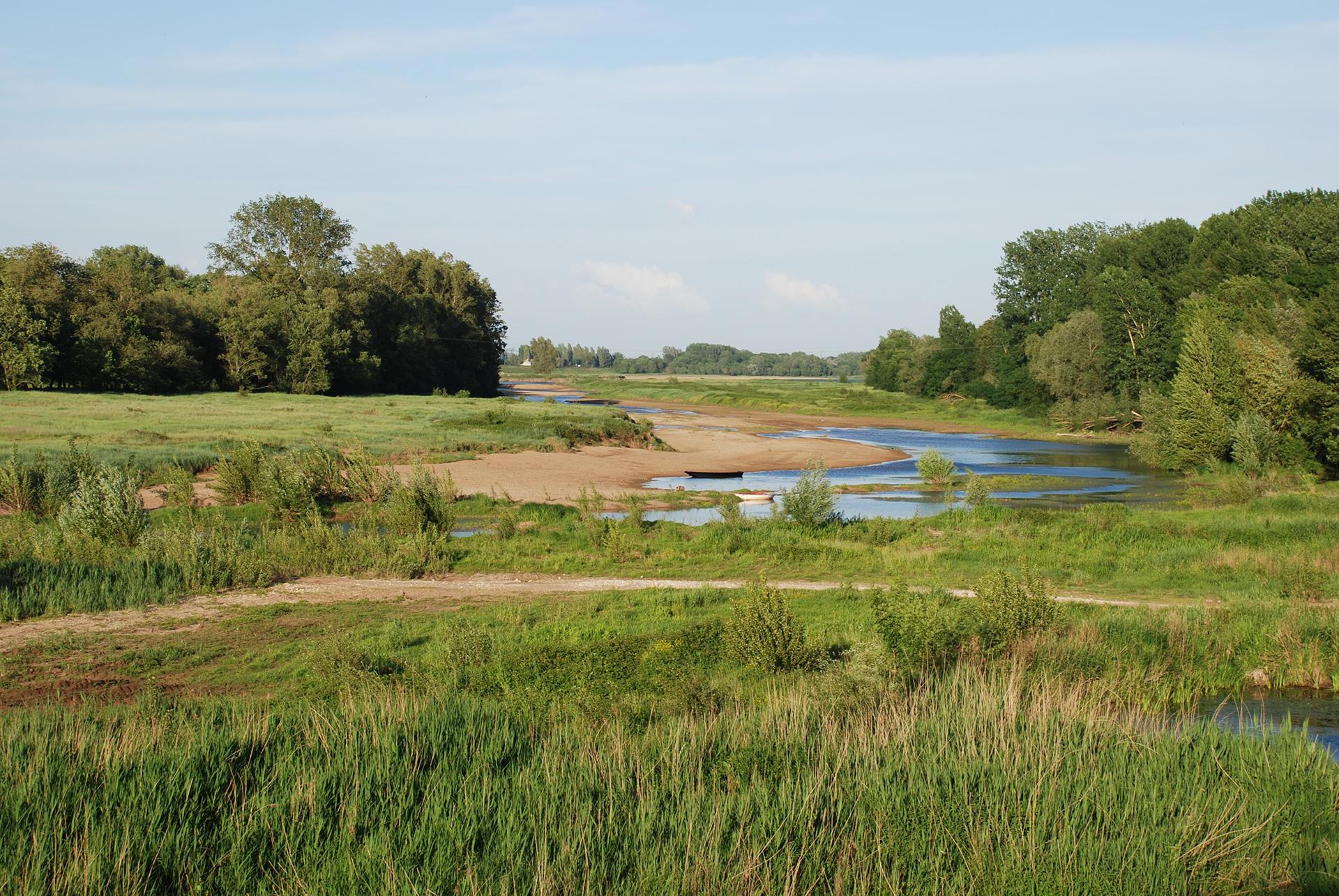
State of groundwater: monitoring by BRGM
Groundwater is a widely used resource: in metropolitan France, it accounts for nearly two-thirds of drinking water consumption and more than one-third of agricultural water consumption. It is also widely used in the industrial sector. Groundwater tables depend on cyclical recharges.
BRGM monitors groundwater levels and quality in mainland France. Discover the actions carried out by the French geological survey and the resources and databases available on groundwater in France.
Press contact


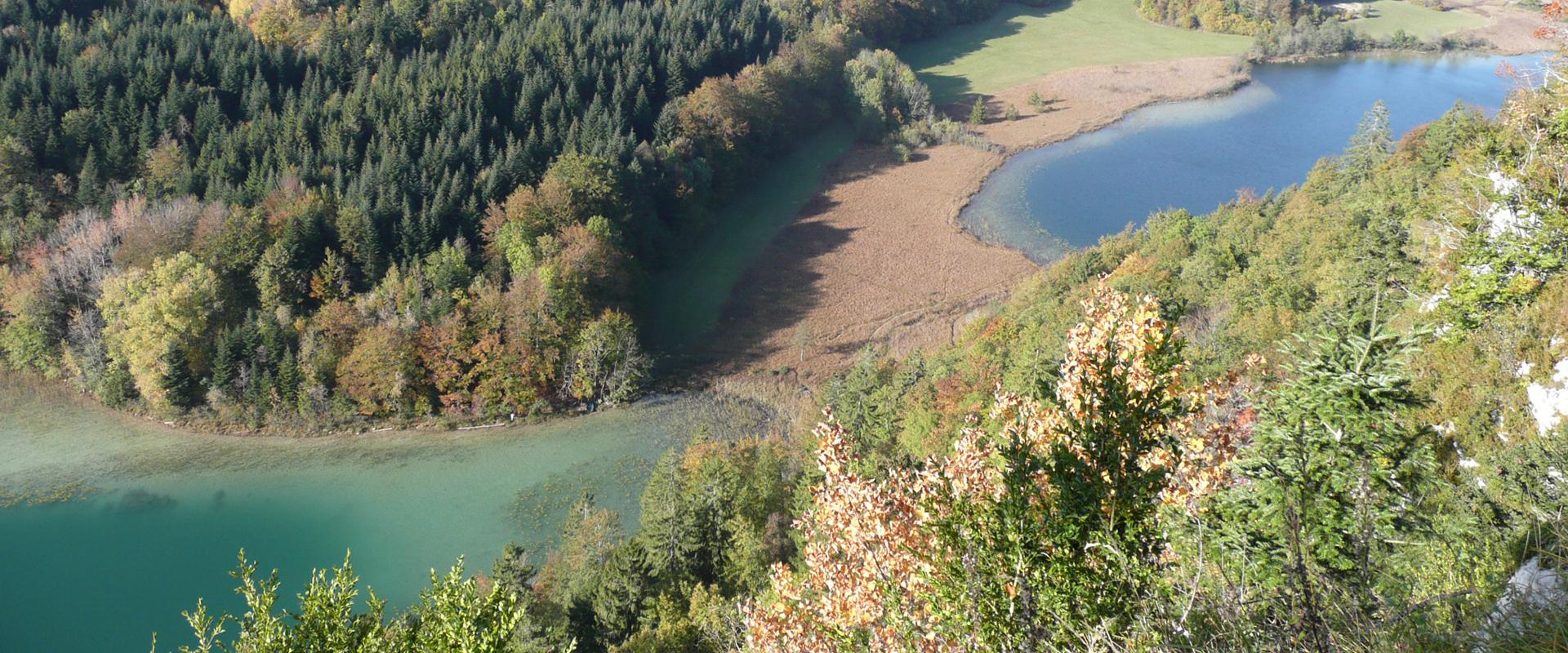
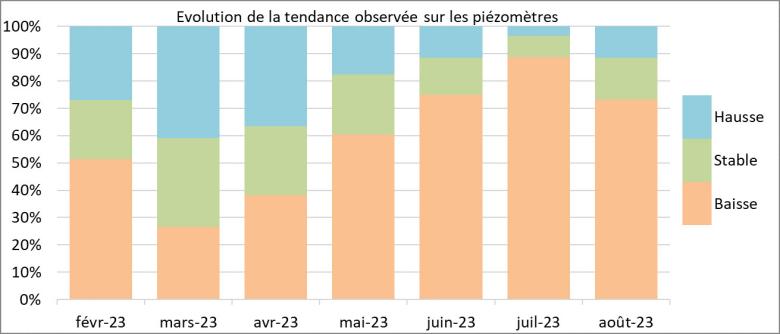
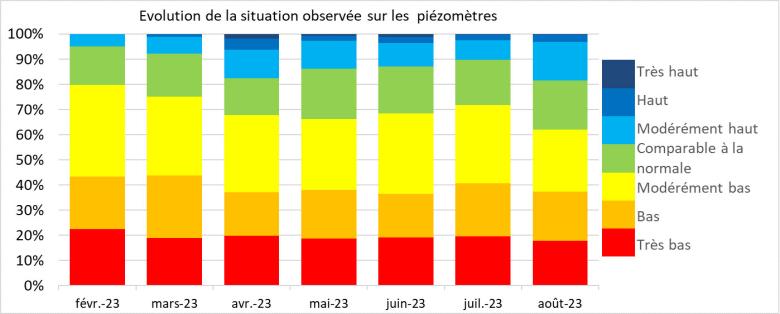




Map drawn up by BRGM on 11 September 2023, based on data from the ADES database, acquired up to 31 August 2023. Data source: ADES database (ades.eaufrance.fr) / Hydroportail (hydro.eaufrance.fr) / Background map © IGN. Data producers and contributors: APRONA, BRGM, Conseil Départemental de la Vendée, Conseil Départemental des Landes, Conseil Départemental du Lot, EPTB Vistre Vistrenque, Parc Naturel Régional des Grandes Causses, Syndicat Mixte d'Etudes et de Travaux de l'Astien (SMETA), Syndicat Mixte pour la protection et la gestion des nappes souterraines de la plaine du Roussillon (SMNPR).
This map shows the global indicators reflecting the average fluctuations of the aquifers. They are based on point indicators collected at groundwater monitoring points (by means of piezometers).
The "Aquifer levels" indicator compares the current month’s figures with those of the same months in the entire record, i.e. at least 15 years of data and sometimes up to as much as 100 years of data. It is divided into 7 classes, from the lowest level (in red) to the highest (in dark blue).
The grey areas correspond to areas without unconfined aquifers, i.e. with an impermeable or semi-permeable layer above the aquifer, and/or sectors with a very low density of measuring points. This last case primarily concerns mountainous areas with small, heterogeneous aquifers.
The "Evolution of levels" indicator reflects the variation of the water level of the past month compared to the two previous months (stable, increasing or decreasing).
These global indicators reflect general situations and trends and do not take into account possible local disparities.